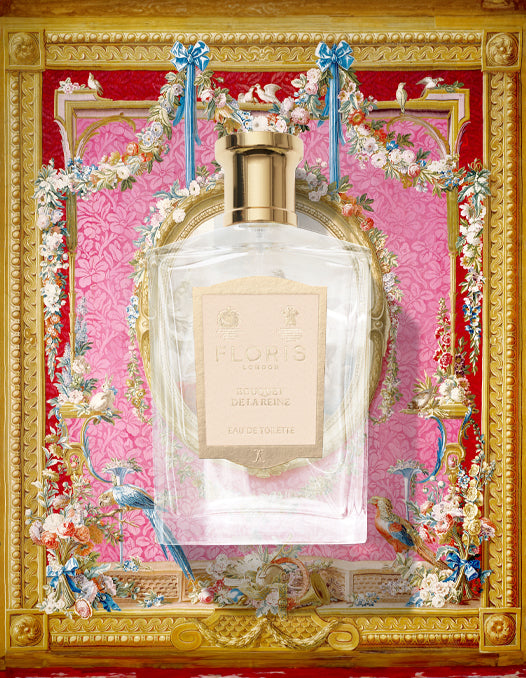The A - Z of fragrance: A glossary of Floris perfume terminology
The Definition of Scent

Absolute: A highly concentrated fragrant mixture extracted from natural materials. As opposed to essential oils, water or steam are not used in the extraction.
Accord: Term borrowed from the musical concept of chords, a harmonious blend of multiple fragrance notes that creates a distinct aroma character.
Aldehyde: Class of aroma molecules characterised by their similar structure used to create a fresh, sparking effect on scent
Aromatic: A fragrance category featuring herbal and fresh notes such as lavender, sage, and basil.
Base Notes: The warmest notes used in perfumery, providing depth, longevity, and richness. These notes develop over time and linger on the skin.

Benzoin: A fragrant resin taken from different types of Styrax trees, with a sweet, balsamic scent. Used in the base notes to enhance the longevity of a fragrance.
Bergamot: A bitter, inedible citrus fruit, grown in Southern Italy, it is a key note in Earl Grey Tea.
Chypre: A scent category characterized by earthy, mossy, and woody notes, often featuring bergamot, oakmoss, labdanum and patchouli.
Dry Down: The final stage of a fragrance's evolution, characterized by the lingering scent left on the skin after the top and heart notes have dissipated.
Eau de Cologne: A traditionally citrus-based fragrance with a lower concentration of aromatic compounds, offering a refreshing and invigorating scent.
Eau de Parfum: A fragrance product composed of perfume concentrate, alcohol, water, and other additives. Usually more concentrated than Eau de Toilette.
Eau de Toilette: A fragrance product composed of perfume concentrate, alcohol, water, and other additives. Usually sprayable on skin.
Frankincense: A resin derived from the Boswellia tree (also known as Olibanum)
Gourmand: A fragrance category inspired by edible aromas, featuring sweet, rich, and indulgent notes such as vanilla, caramel, and chocolate.
Heart Notes: Also known as middle or the body of the fragrance, these emerge once the top notes dissipate, forming the core of the fragrance's composition.
Neroli: An oil from the blossoms of the bitter orange tree.
Notes: Individual scent components that contribute to a fragrance's overall aroma. Classified into top, heart, and base notes based on their volatility and evaporation rate.
Nose: A skilled perfumer responsible for creating fragrances by blending various aromatic ingredients to achieve a desired scent profile.
Labdanum: A sticky resin gathered from the Mediterranean Rock Rose.
Layering: The practice of combining multiple fragrances or scented products to create a personalized scent experience, enhancing complexity and longevity.
Mimosa: Producing cloud like yellow flowers, with notes that are powdery, sweet and green.
Musk: An animalic ingredient in perfumery, musk deer have long been protected and a synthetic variation is used.
Olfactory Family: Classification of fragrances based on their dominant scent characteristics. Common families include citrus, floral, woody and amber.
Osmanthus: A flowering plant native to Asia, known for its small, fragrant flowers, with sweet, fruity-floral apricot-like undertones.
Orris: The roots of Iris tubers.
Oud: The Arabic name for Agarwood, a tree native to South East Asia.
Palmarosa: A grass native to India, with a rose and citrus scent.
Patchouli: A herb related to the mint family, with a deep, earthy, woody scent.
Petitgrain: An essential oil with a green, woody smell from the bark and leaves of citrus trees.
Sandalwood: A revered tree originating from India, classified as a soft wood due to the creamy, soft, notes it imparts on a composition.
Sillage: The trail or aura of fragrance left behind by a person wearing perfume, often described as the scent's projection.
Stephanotis: A flowering variety of jasmine, native to Madagascar. The flower was traditionally used in bridal bouquets.
Top Notes: The initial impression of a fragrance, perceived immediately upon application. Often light and volatile, these notes evaporate quickly.
Tonka: A seed with a comforting nutty, vanilla-like aroma.
Vetiver: A fragrant grass native to India
Ylang Ylang: An evergreen tree growing in Asia and Australia, producing star shaped yellow flowers, that are distilled for their fragrant oil.

